Mingkai Deng
SimuRA: Towards General Goal-Oriented Agent via Simulative Reasoning Architecture with LLM-Based World Model
Jul 31, 2025



Abstract:AI agents built on large language models (LLMs) hold enormous promise, but current practice focuses on a one-task-one-agent approach, which not only falls short of scalability and generality, but also suffers from the fundamental limitations of autoregressive LLMs. On the other hand, humans are general agents who reason by mentally simulating the outcomes of their actions and plans. Moving towards a more general and powerful AI agent, we introduce SimuRA, a goal-oriented architecture for generalized agentic reasoning. Based on a principled formulation of optimal agent in any environment, \modelname overcomes the limitations of autoregressive reasoning by introducing a world model for planning via simulation. The generalized world model is implemented using LLM, which can flexibly plan in a wide range of environments using the concept-rich latent space of natural language. Experiments on difficult web browsing tasks show that \modelname improves the success of flight search from 0\% to 32.2\%. World-model-based planning, in particular, shows consistent advantage of up to 124\% over autoregressive planning, demonstrating the advantage of world model simulation as a reasoning paradigm. We are excited about the possibility for training a single, general agent model based on LLMs that can act superintelligently in all environments. To start, we make SimuRA, a web-browsing agent built on \modelname with pretrained LLMs, available as a research demo for public testing.
LLM360 K2: Building a 65B 360-Open-Source Large Language Model from Scratch
Jan 16, 2025



Abstract:We detail the training of the LLM360 K2-65B model, scaling up our 360-degree OPEN SOURCE approach to the largest and most powerful models under project LLM360. While open-source LLMs continue to advance, the answer to "How are the largest LLMs trained?" remains unclear within the community. The implementation details for such high-capacity models are often protected due to business considerations associated with their high cost. This lack of transparency prevents LLM researchers from leveraging valuable insights from prior experience, e.g., "What are the best practices for addressing loss spikes?" The LLM360 K2 project addresses this gap by providing full transparency and access to resources accumulated during the training of LLMs at the largest scale. This report highlights key elements of the K2 project, including our first model, K2 DIAMOND, a 65 billion-parameter LLM that surpasses LLaMA-65B and rivals LLaMA2-70B, while requiring fewer FLOPs and tokens. We detail the implementation steps and present a longitudinal analysis of K2 DIAMOND's capabilities throughout its training process. We also outline ongoing projects such as TXT360, setting the stage for future models in the series. By offering previously unavailable resources, the K2 project also resonates with the 360-degree OPEN SOURCE principles of transparency, reproducibility, and accessibility, which we believe are vital in the era of resource-intensive AI research.
Web2Code: A Large-scale Webpage-to-Code Dataset and Evaluation Framework for Multimodal LLMs
Jun 28, 2024



Abstract:Multimodal large language models (MLLMs) have shown impressive success across modalities such as image, video, and audio in a variety of understanding and generation tasks. However, current MLLMs are surprisingly poor at understanding webpage screenshots and generating their corresponding HTML code. To address this problem, we propose Web2Code, a benchmark consisting of a new large-scale webpage-to-code dataset for instruction tuning and an evaluation framework for the webpage understanding and HTML code translation abilities of MLLMs. For dataset construction, we leverage pretrained LLMs to enhance existing webpage-to-code datasets as well as generate a diverse pool of new webpages rendered into images. Specifically, the inputs are webpage images and instructions, while the responses are the webpage's HTML code. We further include diverse natural language QA pairs about the webpage content in the responses to enable a more comprehensive understanding of the web content. To evaluate model performance in these tasks, we develop an evaluation framework for testing MLLMs' abilities in webpage understanding and web-to-code generation. Extensive experiments show that our proposed dataset is beneficial not only to our proposed tasks but also in the general visual domain, while previous datasets result in worse performance. We hope our work will contribute to the development of general MLLMs suitable for web-based content generation and task automation. Our data and code will be available at https://github.com/MBZUAI-LLM/web2code.
RLPrompt: Optimizing Discrete Text Prompts With Reinforcement Learning
May 25, 2022
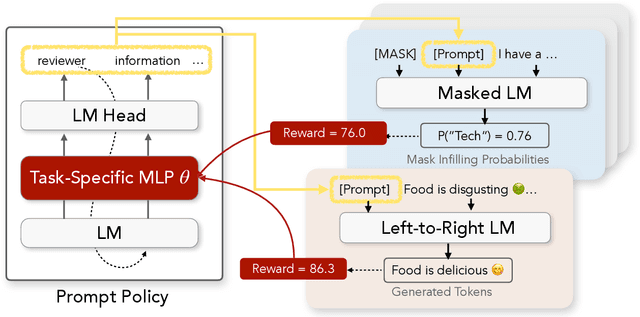

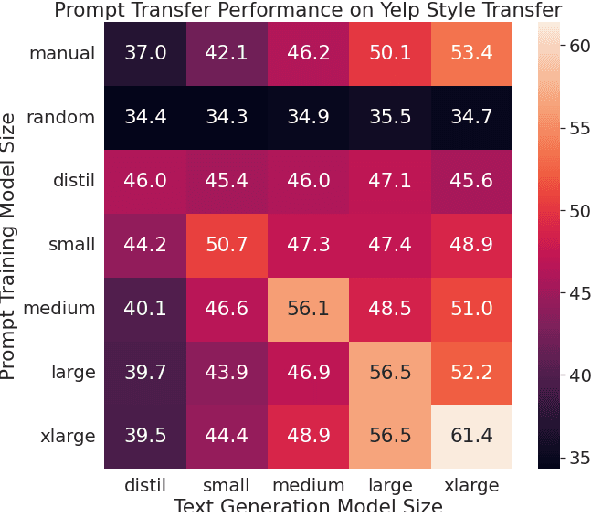
Abstract:Prompting has shown impressive success in enabling large pretrained language models (LMs) to perform diverse NLP tasks, especially when only few downstream data are available. Automatically finding the optimal prompt for each task, however, is challenging. Most existing work resorts to tuning soft prompt (e.g., embeddings) which falls short of interpretability, reusability across LMs, and applicability when gradients are not accessible. Discrete prompt, on the other hand, is difficult to optimize, and is often created by "enumeration (e.g., paraphrasing)-then-selection" heuristics that do not explore the prompt space systematically. This paper proposes RLPrompt, an efficient discrete prompt optimization approach with reinforcement learning (RL). RLPrompt formulates a parameter-efficient policy network that generates the desired discrete prompt after training with reward. To overcome the complexity and stochasticity of reward signals by the large LM environment, we incorporate effective reward stabilization that substantially enhances the training efficiency. RLPrompt is flexibly applicable to different types of LMs, such as masked (e.g., BERT) and left-to-right models (e.g., GPTs), for both classification and generation tasks. Experiments on few-shot classification and unsupervised text style transfer show superior performance over a wide range of existing finetuning or prompting methods. Interestingly, the resulting optimized prompts are often ungrammatical gibberish text; and surprisingly, those gibberish prompts are transferrable between different LMs to retain significant performance, indicating LM prompting may not follow human language patterns.
Compression, Transduction, and Creation: A Unified Framework for Evaluating Natural Language Generation
Sep 14, 2021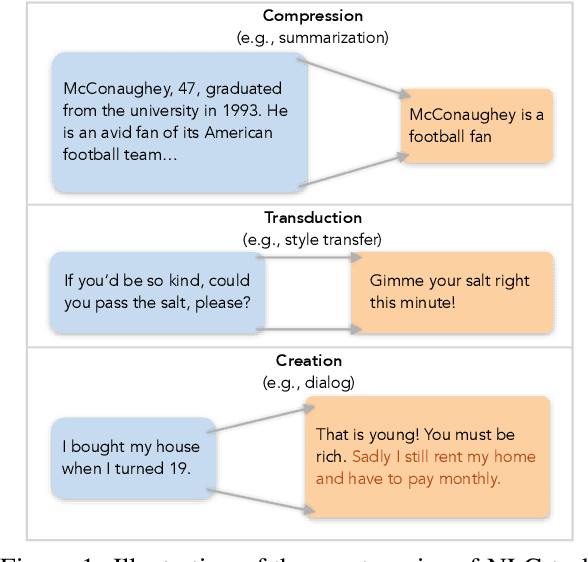
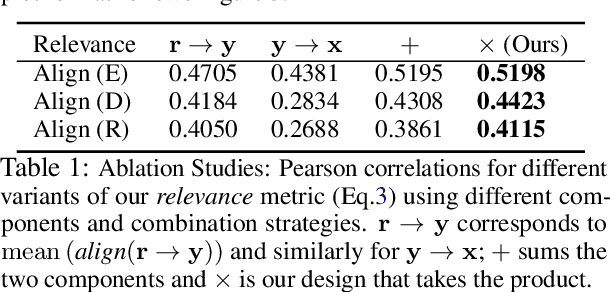

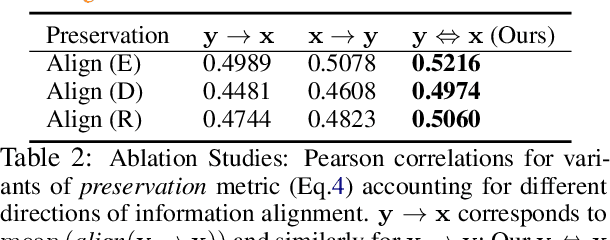
Abstract:Natural language generation (NLG) spans a broad range of tasks, each of which serves for specific objectives and desires different properties of generated text. The complexity makes automatic evaluation of NLG particularly challenging. Previous work has typically focused on a single task and developed individual evaluation metrics based on specific intuitions. In this paper, we propose a unifying perspective based on the nature of information change in NLG tasks, including compression (e.g., summarization), transduction (e.g., text rewriting), and creation (e.g., dialog). Information alignment between input, context, and output text plays a common central role in characterizing the generation. With automatic alignment prediction models, we develop a family of interpretable metrics that are suitable for evaluating key aspects of different NLG tasks, often without need of gold reference data. Experiments show the uniformly designed metrics achieve stronger or comparable correlations with human judgement compared to state-of-the-art metrics in each of diverse tasks, including text summarization, style transfer, and knowledge-grounded dialog.
 Add to Chrome
Add to Chrome Add to Firefox
Add to Firefox Add to Edge
Add to Edge